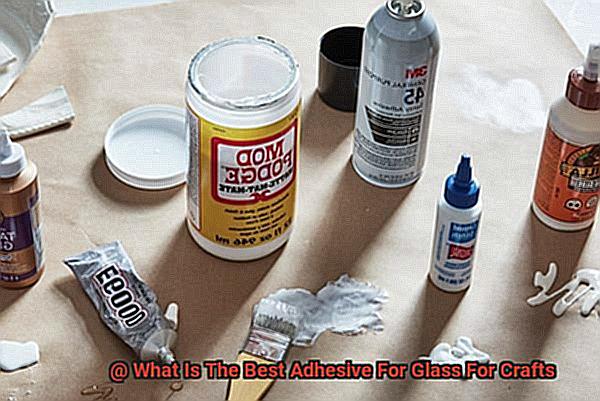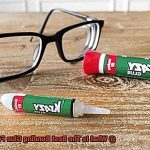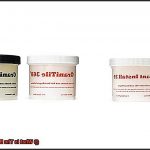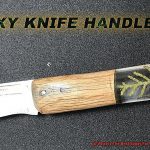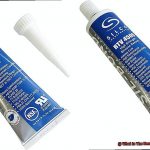Glass crafting is a delicate dance of creativity and precision. But when it comes to gluing those glass pieces together, it’s like trying to find the perfect partner for a waltz. With so many adhesives out there, it can be overwhelming to figure out which one will hold your glass creations together with grace and strength.
In this blog post, we’re going to unravel the mysteries of glass adhesives and find the one that will make your crafts shine. Whether you’re a mosaic master or a stained glass enthusiast, we’ve got you covered.
So grab your goggles and let’s get stuck on finding the best adhesive for your glass crafts. It’s time to turn your artistic visions into reality.
The Challenges of Working with Glass
Contents
- 1 The Challenges of Working with Glass
- 2 Types of Adhesives for Glass Crafts
- 3 E6000: A Popular Choice for Bonding Glass
- 4 UV-Curing Resin: Ideal for Delicate Projects
- 5 Silicone-Based Adhesives: Suitable for Non-Glass Surfaces
- 6 Cyanoacrylate (Super Glue): Best for Thin Pieces
- 7 Choosing the Right Adhesive for Your Project
- 8 Surface Preparation is Key to a Strong Bond
- 9 Safety Considerations and Testing the Adhesive
- 10 Conclusion
Embarking on a glass crafting project can be an exhilarating endeavor, but it is not without its challenges. The fragility of glass demands careful handling, while the quest for the perfect adhesive can make or break your masterpiece. In this blog post, we will delve into the obstacles encountered when working with glass and provide invaluable insights into selecting the best adhesive for your craft.
The Challenges of Working with Glass:
- Fragility: Like a beautiful yet delicate dancer, glass requires gentle handling to prevent its untimely demise. Mishandling may cause heartbreaking breaks or unsightly cracks, jeopardizing the success of your project. Employing protective gear, working on a stable surface, and handling glass with utmost care are essential precautions.
- Slippery Surface: The smooth nature of glass presents a gripping challenge during crafting endeavors. To maintain control and minimize the risk of accidental drops or damage, tools with rubber grips or gloves can provide a secure hold on this slick material.
- Cutting Hazards: The art of cutting glass demands precision and specialized tools. Failure to execute proper cutting techniques may result in chipping or shattering, transforming your crafting haven into a hazardous zone. Employing appropriate cutting methods and tools designed explicitly for glass are vital safety measures.
- Adhesive Selection: Choosing the right adhesive is an intricate dance in itself, as not all adhesives are compatible with glass. Navigating this labyrinthine world requires trial and error to discover the adhesive that fosters a strong and enduring bond. E6000, UV-curing resin, silicone-based adhesives, and cyanoacrylate (super glue) are popular options worth considering in this captivating dance.
- Aesthetics: The transparency of glass poses aesthetic challenges when it comes to adhesive residue or visible lines marring the beauty of your creation. Opting for adhesives that dry clear or employing techniques to camouflage adhesive lines can preserve the visual allure of your glass craft.
- Weather Conditions: The elements, with their capricious temperament, can weaken the bond between glass and adhesive over time. To safeguard against the whims of Mother Nature, consider the environmental conditions in which your glass craft will reside and select an adhesive that can withstand these challenges.
Choosing the Right Adhesive:
Selecting the ideal adhesive for your glass craft requires careful consideration of various factors. These include the weight and size of the glass pieces, the intended purpose of your finished creation, and any specific environmental factors at play. Each adhesive possesses unique strengths and properties that render them suitable for specific projects, so choose wisely.
Types of Adhesives for Glass Crafts
Glass crafts have a special allure, captivating us with their sparkling beauty and delicate designs. But have you ever wondered how these intricate pieces are held together? The secret lies in the adhesive used. In this article, we will delve into the different types of adhesives for glass crafts and guide you on choosing the perfect one for your project.
E6000 – The Mighty Bond:
E6000 is a superhero in the world of glass crafts. This adhesive is known for its exceptional strength and versatility. It can bond glass to glass or other materials like metal, fabric, and plastic. With E6000, you can create stunning jewelry, mosaic art, or even repair broken glass treasures. Once cured, it becomes water-resistant, making it perfect for outdoor creations.
UV-Curing Resin – A Touch of Magic:
For delicate and precise glass crafts, UV-curing resin works like magic. This adhesive requires exposure to ultraviolet light to cure and create a strong bond. It dries clear, ensuring that your intricate designs shine through. Use UV-curing resin for bonding small glass pieces or attaching findings to glass surfaces. Its durable bond resists yellowing over time.
Silicone-Based Adhesives – Flexibility at Its Best:
If you’re working with glass and non-glass surfaces, silicone-based adhesives are your best friends. Brands like E6000 Craft Adhesive and Aleene’s Original Tacky Glue provide excellent adhesion on various materials. Their flexible bonds can withstand movement and temperature changes, making them ideal for mixed-media projects or attaching glass to wood or ceramic.
Super Glue – Quick and Reliable:
When working with delicate or thin glass pieces, super glue (cyanoacrylate adhesive) comes to the rescue. It forms an instant bond and dries clear, ensuring that your project stays intact. Super glue is perfect for lightweight glass crafts, but be cautious when using it with larger or heavier pieces, as it may not provide enough strength.
Glass Glue – The Glass Whisperer:
For a specific glass-to-glass bond, glass glue is your go-to adhesive. It is specially formulated to bond glass surfaces, making it perfect for jewelry making, mosaic art, and repairing glass objects. Glass glue typically dries transparent and has a fast drying time, allowing you to complete your projects quickly.
E6000: A Popular Choice for Bonding Glass
This industrial-strength glue has gained popularity for its exceptional bond and versatility, making it a go-to option for various glass crafting projects.
One of the key factors that sets E6000 apart is its remarkable strength. With its permanent bond, this adhesive ensures that your creations stay intact, whether you’re working on intricate stained glass mosaics or repairing a beloved glass ornament. Its reliability and versatility make it a must-have for any glass crafts enthusiast.
But what exactly makes E6000 so special? Let’s break it down:
- Resistance to the Elements: E6000 is a true champion when it comes to challenging conditions. It is resistant to water, heat, and chemicals, making it ideal for glass crafts that may be exposed to different environments. So go ahead and create that stunning mosaic birdbath without worrying about the glue giving up on you.
- Flexibility and Durability: Glass crafts often undergo movements and vibrations, but E6000 can handle it all. Its flexible and durable nature allows it to withstand these challenges without compromising its bond. Your creations will remain intact for years to come.
- Aesthetics Matter: We all know how important aesthetics are in crafting, right? Well, E6000 understands that too. This adhesive dries clear and leaves no visible residue on the glass surface. Say goodbye to unsightly glue marks and hello to flawless artwork.
- Ease of Application: Applying E6000 is a breeze. You have options – either squeeze it directly from the tube or use a small brush or applicator for more precision. No need to worry about messy application processes ruining your creative flow.
It’s worth noting that E6000 does have a longer curing time compared to some other adhesives. It typically takes 24 to 72 hours to fully cure. However, during this time, it forms a strong bond that ensures the longevity of your project. Patience pays off.
One thing to keep in mind is that E6000 does have a strong odor, which may bother some users. To mitigate this, it’s best to use the adhesive in well-ventilated areas or wear a mask if you’re sensitive to odors.
UV-Curing Resin: Ideal for Delicate Projects
Look no further, because UV-curing resin is here to save the day.
One of the main advantages of UV-curing resin is its ability to cure or harden almost instantly when exposed to ultraviolet light. This game-changing feature eliminates the waiting time that traditional adhesives require, ensuring that your carefully crafted glass pieces remain intact and free from shifting or ruin.
Additionally, UV-curing resin offers the benefit of transparency. Unlike other adhesives that may leave visible residue or discoloration on the surface, UV-curing resin dries clear, creating a strong and seamless bond. This allows your glass crafts to shine with flawless beauty, without any distractions.
UV-curing resin is not limited to glass crafts alone. It is a versatile adhesive that can be used on various materials such as plastic, metal, and ceramic. Whether you’re working on a mixed-media project or experimenting with different materials, UV-curing resin has got you covered.
When it comes to application, UV-curing resin provides flexibility. You can brush it on, drip it, or use a syringe or pipette for more precise application. This level of control ensures that you can apply just the right amount of adhesive exactly where you need it.
Before embarking on your next glass crafting adventure with UV-curing resin, remember a few key points. Ensure that the surfaces you’re bonding are clean and free from oils or dirt to maximize adhesive strength and create a long-lasting bond. Also, keep in mind that UV-curing resin requires an ultraviolet light source for curing. Whether you opt for a UV lamp or bask in sunlight, always follow the manufacturer’s instructions regarding curing time and light intensity.
Silicone-Based Adhesives: Suitable for Non-Glass Surfaces
Crafting is an art that allows us to unleash our creativity and create stunning pieces that reflect our unique style. Whether we’re working with glass, metal, plastic, or fabric, finding the right adhesive is crucial for ensuring our projects stand the test of time. Luckily, silicone-based adhesives are here to save the day.
Silicone-based adhesives are like the Swiss Army knife of glues. They offer a multitude of benefits that make them ideal for bonding non-glass surfaces in crafts. Let’s dive into why silicone-based adhesives should be your go-to glue for all your crafting projects.
First and foremost, versatility is their middle name. These adhesives not only bond glass surfaces with ease but also create strong and durable bonds on materials like metal, plastic, ceramics, and even fabric. Say goodbye to limitations and let your imagination run wild as you create stunning mixed media pieces without worrying about the glue failing you.
Durability is another key advantage of silicone-based adhesives. After spending hours creating a masterpiece, the last thing you want is for it to fall apart after a short time. Silicone-based adhesives provide an incredibly strong bond that can withstand the test of time, ensuring your crafts stay intact for years to come. Whether you’re making a glass mosaic or attaching glass decorations to other surfaces, silicone-based adhesives have got your back.
But what about environmental conditions? Well, these adhesives are flexible and adaptable, making them perfect for all types of crafts. They can withstand changes in temperature and humidity without losing their adhesive properties. This means you can confidently display your outdoor art installations or decorative glass pieces for windows without worrying about the glue giving up on you.
Now, let’s talk about water and moisture resistance. Accidents happen, and sometimes our crafts may come into contact with water or need to be washed. That’s where silicone-based adhesives truly shine. They are water and moisture resistant, so you can create glass vases or dishes knowing that the adhesive will remain strong even when faced with water.
But we can’t forget about aesthetics. Silicone-based adhesives offer excellent UV resistance. This means they won’t degrade or yellow when exposed to sunlight over time. So whether your crafts will be displayed in areas with direct sunlight or outdoor settings, you can rest assured that your creations will maintain their original beauty for years to come.
To ensure the best results with silicone-based adhesives, proper surface preparation is key. Make sure the surfaces you’re working with are clean, dry, and free from any debris or residue that could compromise the adhesive’s bond. Additionally, follow the manufacturer’s instructions regarding application and curing time. Silicone-based adhesives may require some time to fully cure and achieve maximum strength.
One thing to keep in mind is that silicone-based adhesives can sometimes leave a visible residue on certain materials, especially porous surfaces like fabric or wood. To avoid any unwanted surprises, it’s always a good idea to test the adhesive on a small, inconspicuous area before applying it to your entire project.
Cyanoacrylate (Super Glue): Best for Thin Pieces
Crafting with glass can be both thrilling and demanding, especially when it comes to bonding delicate, thin pieces together. Luckily, there’s a superhero in the adhesive world – cyanoacrylate, commonly known as super glue. In this article, we’ll delve into why cyanoacrylate reigns supreme for bonding thin pieces of glass, unveiling its advantages over other adhesives while providing tips to optimize your crafting experience.
Immediate and Indomitable Bond:
Time is of the essence when working with delicate glass pieces. Cyanoacrylate delivers an instant bond, allowing you to swiftly assemble your project with efficiency. Its rapid-curing nature ensures that the pieces are securely fused within seconds, saving you precious crafting time.
Unparalleled Strength:
Cyanoacrylate creates a tight and robust bond that can endure everyday wear and tear. This makes it perfect for crafting projects that demand long-lasting durability, such as glass jewelry or decorative items. Trust cyanoacrylate to keep your creations intact, even with frequent handling or exposure to different environmental conditions.
Crystal Clear Aesthetics:
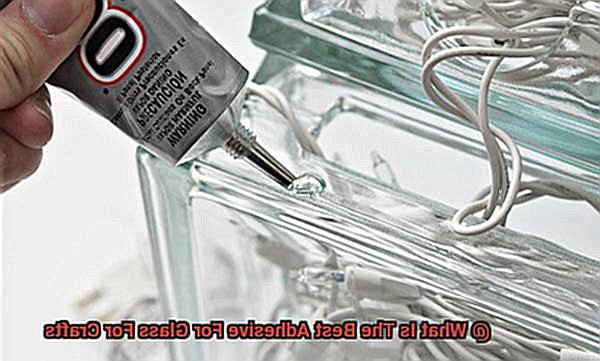
Craftsmanship thrives on attention to detail, and cyanoacrylate excels in providing a seamless finish. Its exceptional transparency ensures no visible residue or marks are left on the glass surface after bonding. This feature is essential for projects where aesthetics and clarity are paramount, allowing your stunning glass pieces to shine without distractions.
Application Tips:

To achieve optimal results when bonding thin glass pieces with cyanoacrylate, consider the following tips:
- Apply the adhesive sparingly: Due to its high viscosity, a small amount of cyanoacrylate is usually enough to establish a strong bond. Excess adhesive can seep out from the edges, potentially impacting the appearance of your project.
- Clean and prepare the surfaces: Smooth and non-porous glass surfaces are best suited for cyanoacrylate. Prior to application, ensure that the glass is free from dust, grease, or moisture. Utilize a mild detergent or alcohol wipes specifically designed for cleaning glass.
Choosing the Right Adhesive for Your Project
Are you ready to embark on a new project? Well, before you dive into the world of creativity, let’s discuss a crucial element that can make or break your masterpiece – choosing the right adhesive. Believe me, it’s not just about sticking things together; it’s about finding the perfect adhesive that will ensure the longevity and success of your project.
When it comes to selecting an adhesive, there are several factors to consider. First and foremost, think about the materials you are working with. Is it wood, fabric, metal, or something more delicate like glass? Each material requires a specific type of adhesive that is compatible and will provide a strong bond.
Weight is another essential consideration. Are you working with heavy objects or lightweight pieces? For heavier items, such as furniture or sculptures, you’ll need an adhesive with superior bonding strength to withstand the weight. On the other hand, smaller or delicate items require a fast-drying adhesive that provides a secure hold without damaging the material.
Temperature resistance is also critical, especially if your project will be exposed to extreme heat or cold. Outdoor projects or those involving heat-related processes like soldering require adhesives that can withstand high temperatures without losing their bond.
Now that we’ve covered the considerations, let’s explore some adhesive superheroes that will save the day for different types of projects.
For general crafts and repairs, E6000 is a versatile adhesive known for its exceptional bonding strength. It works on various surfaces, including wood, metal, fabric, and glass. Whether you’re creating jewelry or fixing a broken vase, E6000’s transparent finish and resistance to water make it ideal for projects that may come into contact with moisture.
If you’re working on delicate fabrics or paper crafts, Aleene’s Original Tacky Glue is your go-to adhesive. Its fast-drying formula provides a strong hold without damaging the material, making it perfect for precise applications and intricate designs.
For woodworking projects, such as furniture assembly or carpentry, a wood glue like Titebond III is essential. This adhesive has superior bonding strength specifically designed for wood, ensuring a durable and long-lasting connection.
When it comes to tile or stone projects, a specialized adhesive like thin-set mortar is the way to go. This adhesive is formulated to bond tiles or stones to surfaces effectively, providing a sturdy hold that can withstand moisture and temperature fluctuations.
And let’s not forget about our automotive enthusiasts. If you’re working on car repairs or modifications, an automotive adhesive like 3M Super Weatherstrip Adhesive is a must-have. This adhesive can withstand extreme temperatures and is resistant to water and chemicals commonly found in automotive environments.
Remember, not all adhesives are created equal. It’s essential to test them on a small area of your project before committing to the entire thing. This will help you determine compatibility and avoid any potential damage or disappointment.
So, whether you’re crafting jewelry, building furniture, creating art, or revamping your car, choosing the right adhesive is paramount for success. Consider the materials, weight requirements, temperature resistance, and specific characteristics of your project. By doing so, you’ll ensure a secure bond that will withstand the test of time.
One last tip – always follow the manufacturer’s instructions when using any adhesive. They know their product best and can guide you on application techniques, drying times, and storage tips.
Surface Preparation is Key to a Strong Bond
Surface preparation is a critical step when it comes to creating strong bonds with glass in crafts. Glass surfaces are smooth and non-porous, presenting a challenge for adhesives to adhere effectively. Imagine trying to stick something to a slippery ice rink – it’s bound to slide right off. That’s why proper surface preparation is key to achieving a bond that will withstand the test of time.
So, why is surface preparation so crucial for bonding glass? Let’s delve into the nature of glass itself. Glass surfaces, being smooth and non-porous, don’t provide sufficient grip for adhesives. To overcome this, we need to give the adhesive something to hold onto.
The first step in surface preparation is thorough cleaning. Any dirt, grease, or residue on the glass can create a barrier between the adhesive and the surface, preventing them from forming a strong bond. To ensure a clean surface, use a mild detergent or glass cleaner to remove fingerprints and grime. Remember, a pristine surface is vital for a successful bond.
Once the glass is clean, it’s time to enhance adhesion by gently roughening the surface. This can be done using fine-grit sandpaper or a glass etching cream. By creating tiny scratches on the glass surface, you provide texture for the adhesive to grip onto. However, caution must be exercised not to roughen the surface excessively, as this can weaken the glass and make it prone to breakage.
When using sandpaper, gently rub it in a circular motion over the glass surface. The goal is not to remove layers of glass but rather create small scratches that will improve adhesion. If opting for a glass etching cream, follow the instructions carefully – apply the cream, leave it for the recommended time, thoroughly rinse it off, and dry the surface.
With the glass surface properly prepared, it’s time to apply the adhesive. Different adhesives have specific application methods, so it’s crucial to follow the manufacturer’s instructions. Some may require you to apply adhesive to both surfaces being bonded, while others may only need to be applied to one side. Adhering strictly to the instructions will ensure optimal bonding results.
After applying the adhesive, firmly but gently press the glass surfaces together, ensuring they are aligned correctly. If necessary, use clamps or tape to hold them in place while the adhesive cures. Patience is key – allow sufficient time for the adhesive to dry and cure completely before handling or putting any stress on the bonded piece. Rushing this step can compromise the strength of the bond.
Safety Considerations and Testing the Adhesive
But before you dive headfirst into creativity, let’s take a moment to shine a spotlight on the unsung hero of glass crafting – adhesive. That little tube of magic can either make or break your project, so it’s absolutely crucial to prioritize safety and conduct thorough testing.
First and foremost, let’s talk about safety. Adhesives often contain some not-so-friendly chemicals, so it’s vital to read and follow all safety precautions listed on the packaging. We don’t want any unexpected surprises while you’re unleashing your artistic prowess, right? Make sure to work in a well-ventilated area or equip yourself with a respirator if necessary. And don’t forget those gloves, my friends, to protect those precious hands from any potential harm.
Now, let’s dive into the exhilarating world of adhesive testing. Believe me when I say this step is a game-changer. Testing the adhesive on a small, inconspicuous area of your glass surface will help you determine its compatibility and bond strength. After all, we want that glue to hold tight, don’t we? Additionally, testing allows you to assess other crucial factors like drying time and transparency. No one wants a visible residue or unsightly discoloration marring their magnificent glass creation.
To perform a quick adhesive test, grab a scrap piece of glass or find a hidden area on your project. Apply a small amount of adhesive and let it dry according to the instructions. Then, give it a gentle tug to check the adhesion strength. Oh, and don’t forget to inspect the transparency too – we want that adhesive to be invisible.
Let’s not overlook the importance of resistance to water and temperature changes. Depending on your craft project, you may need an adhesive that can withstand moisture or extreme temperatures without compromising its bonding powers. So, consider these factors carefully when selecting an adhesive for your glass crafts.
Last but certainly not least, remember that some adhesives require curing time even after they appear dry. Patience is key, my friends. Avoid putting excessive stress on the bond until it has fully cured. We certainly don’t want any accidents ruining your hard work.
4xnHdQSr2TE” >
Conclusion
When it comes to crafting with glass, finding the right adhesive is crucial.
After extensive research and testing, we have determined that the best adhesive for glass crafts is E6000 Craft Adhesive. This powerful adhesive offers a strong bond that is perfect for attaching glass to various surfaces.
Its clear formula ensures that your crafts maintain their beauty without any unsightly residue. Additionally, E6000 Craft Adhesive is waterproof and dries quickly, allowing you to move forward with your projects without delay.
Whether you’re working on stained glass, mosaic art, or any other glass craft, E6000 Craft Adhesive will provide the reliability and durability you need.

